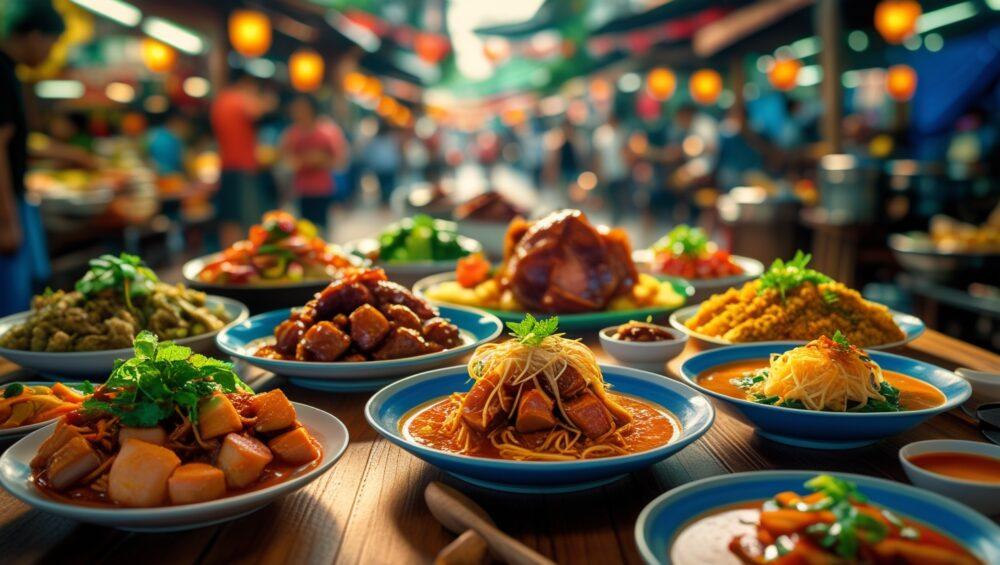Philippines Food: A Rich Culinary Experience
Philippines food is a vibrant and flavorful reflection of the country’s diverse culture, rich history, and varied geography. With more than 7,000 islands stretching across the Pacific Ocean, each region of the Philippines contributes its own local ingredients, cooking methods, and culinary traditions, resulting in a cuisine that is as diverse as it is delicious.
At the heart of Filipino cuisine is a fusion of cultural influences. Over centuries, the Philippines absorbed flavors and techniques from Spanish colonizers, Chinese traders, Malay neighbors, and later American settlers—all while preserving indigenous Filipino food traditions. The result is a cuisine that seamlessly blends east and west, savory and sweet, comfort and celebration.
A Feast of Flavors
Philippines food is known for its bold flavor combinations, often bringing together seemingly contrasting tastes—like vinegar’s tang with soy sauce’s saltiness, or the sweetness of coconut milk balanced by the heat of native chilies. Staples like garlic, onion, ginger, lemongrass, calamansi, and banana leaves form the foundation of many Filipino dishes, giving them their distinct aroma and depth.
Rice is the centerpiece of nearly every Filipino meal, served with a variety of meats, vegetables, broths, or seafood. Because the Philippines is an archipelago, fish and shellfish feature heavily in coastal regions, while inland areas may favor pork, chicken, or beef stews and barbecues.
Food as a Cultural Expression
Food in the Philippines is more than just sustenance—it’s a celebration of community, family, and heritage. Shared meals are a cultural norm, with dishes placed at the center of the table and everyone helping themselves. Whether it’s a small gathering or a lavish fiesta, food is central to every Filipino occasion.
Dishes are often passed down through generations, with each family putting its own spin on classics like adobo, sinigang, or pancit. And because Filipino cuisine is deeply tied to seasonal and local ingredients, it reflects the rhythms of nature and regional availability—making it incredibly diverse from one island to another.
A Culinary Destination on the Rise
In recent years, Philippines food has gained international recognition, thanks in part to Filipino chefs who are reimagining traditional dishes for global audiences while staying true to their roots. From bustling street food markets in Manila to elevated dining experiences in Cebu or Davao, the Philippines is becoming a must-visit destination for food travelers and culinary adventurers.
Whether you’re craving slow-cooked stews like kare-kare, savory grilled street snacks like isaw, or tropical desserts like halo-halo and ube halaya, the Philippines delivers a food experience that is hearty, soulful, and deeply personal.
In this guide, you’ll explore not just the dishes, but the stories, people, and places behind them—making it easy to see why Filipino food is capturing hearts and appetites around the world.
Philippines food stands out for its rich interplay of flavors, textures, and cultural storytelling. At its core, Filipino cuisine is defined by its remarkable ability to balance contrasting tastes—where sweet meets salty, sour cuts through richness, and umami ties it all together in harmony. This dynamic flavor profile isn’t accidental; it’s a reflection of the country’s complex history, diverse geography, and deeply rooted culinary traditions.
A Symphony of Flavors
Filipino dishes often combine sweet, salty, sour, and savory in a single bite, creating a layered experience that is both comforting and exciting. For example:
-
Adobo mixes vinegar’s sharpness with soy sauce’s saltiness and garlic’s pungency.
-
Sinigang delivers a refreshing sourness from tamarind or calamansi, often softened with tomatoes and fish sauce.
-
Bicol Express pairs creamy coconut milk with spicy chili and salty fermented shrimp paste.
Unlike other cuisines that prioritize one dominant taste, Philippines food celebrates contrast, encouraging the palate to explore depth and nuance with each mouthful.
Indigenous Roots and Colonial Influences
Filipino cuisine is the result of centuries of cultural exchange. Pre-colonial Filipinos used methods like boiling, grilling, and fermenting with local ingredients like root crops, coconut, seafood, and native fruits. When the Spanish arrived in the 16th century, they introduced stews, sausages, and sweets—leaving a lasting mark with dishes like mechado, caldereta, and lechon.
Later, Chinese traders brought noodles and soy-based dishes, influencing favorites like lumpia (spring rolls) and pancit. American colonization introduced canned goods, fast food, and techniques like frying, seen today in the popularity of dishes like fried chicken with spaghetti (a distinctly Filipino combo).
This blend of indigenous techniques and foreign flavors makes Filipino food familiar yet distinct, especially to those already acquainted with Asian or Latin cuisine.
Ingredients That Define Filipino Cooking
A few key ingredients give Philippines food its unmistakable flavor:
-
Vinegar (suka) – A primary preservative and souring agent used in dishes like adobo and paksiw.
-
Soy Sauce (toyo) – Adds salty umami depth to marinades and stir-fries.
-
Garlic and Onion – Foundational aromatics for nearly every sautéed dish (ginisa).
-
Coconut Milk (gata) – Especially prominent in Bicol and Mindanao cuisine, it adds richness and creaminess.
-
Calamansi – A citrus fruit unique to the Philippines, used for marinating, dipping sauces, and refreshing drinks.
-
Bagoong (fermented shrimp or fish paste) – Intensely flavorful, it’s used as a condiment or mixed into dishes like kare-kare and pinakbet.
A Culture of Sharing and Celebration
Filipino meals are rarely eaten alone. Food is central to community and family life, whether it’s a weekday lunch or a grand fiesta. Meals are traditionally served family-style, with multiple dishes laid out on the table and everyone encouraged to partake. This practice emphasizes hospitality, abundance, and connection—values that are deeply embedded in Filipino society.
It’s common to see people bond over a “boodle fight,” where food is spread out on banana leaves and eaten with bare hands—a fun, communal way to enjoy shared dishes and conversations.
Even outside the home, food continues to bring people together. Street vendors, carinderias (local eateries), and paluto-style restaurants in wet markets allow people from all walks of life to enjoy good food affordably.
Everyday Meals with Festival Spirit
Another aspect that makes Philippines food unique is how everyday meals feel festive, and celebrations feel like feasts. Holidays, birthdays, and even town-wide fiestas are marked by special dishes like lechon, morcon, and lumpiang shanghai, often served alongside rice, noodles, and an array of desserts. But even simple home-cooked meals can include two or three ulam (main dishes) and soup—proving that in Filipino culture, food is joy, love, and a way of life.
.Must-Try Traditional Filipino Dishes
1. Adobo
A national favorite, adobo is meat (usually chicken or pork) stewed in vinegar, soy sauce, garlic, and spices. It’s hearty, deeply savory, and endlessly customizable—every family has their own version.
2. Sinigang
This tangy tamarind-based soup is a comfort food staple, often made with pork, shrimp, or fish and a mix of vegetables. The sour broth is uniquely refreshing, especially on a rainy day.
3. Lechon
Lechon, or roasted whole pig, is a show-stopping dish at fiestas and holidays. The crisp skin and tender, flavorful meat make it one of the most beloved dishes in Philippines food culture.
4. Kare-Kare
A rich peanut stew typically made with oxtail, vegetables, and tripe, kare-kare is served with bagoong (fermented shrimp paste) for a savory punch.
5. Pancit
Pancit refers to various noodle dishes introduced by Chinese immigrants. Popular variations include Pancit Bihon (rice noodles), Pancit Canton (egg noodles), and Pancit Malabon (thick noodles with seafood sauce).
Popular Filipino Street Food
Street food is an essential part of Philippines food culture, especially in urban areas and night markets.
-
Isaw – Grilled chicken or pork intestines, often dipped in vinegar or sweet sauce
-
Balut – A fertilized duck egg, eaten warm with salt and vinegar
-
Kwek-Kwek – Deep-fried quail eggs in orange batter
-
Fish Balls & Squid Balls – Skewered and fried, served with sweet or spicy sauces
-
Taho – Warm silken tofu with syrup and tapioca pearls, typically sold by roaming vendors in the morning
Iconic Filipino Desserts and Sweets
-
Halo-Halo – A layered dessert of crushed ice, sweetened beans, fruits, leche flan, and ube ice cream
-
Leche Flan – A dense caramel custard served at nearly every celebration
-
Bibingka & Puto Bumbong – Rice-based Christmas treats, often enjoyed outside churches after Simbang Gabi
-
Turon – Banana and jackfruit spring rolls fried in caramelized sugar
Regional Specialties Across the Philippines
Luzon
-
Bicol Express – Spicy pork cooked in coconut milk and chilies
-
Laing – Dried taro leaves simmered in coconut cream
-
Bagnet – Crisp, deep-fried pork belly from Ilocos Norte
Visayas
-
Chicken Inasal – Grilled chicken marinated in annatto, calamansi, and vinegar, originating in Bacolod
-
Batchoy – A savory noodle soup from Iloilo with pork organs and crushed chicharon
Mindanao
-
Piaparan – A Maranao dish made with chicken, coconut milk, turmeric, and spices
-
Pastil – Banana leaf-wrapped rice topped with spiced shredded meat, popular in Muslim regions
Where to Eat: From Street Stalls to Fine Dining
In the Philippines, you can experience incredible food in every setting:
-
Carinderias – Affordable roadside eateries serving home-cooked meals
-
Food Markets – Great for sampling street food and local snacks
-
Local Restaurants – Offering classic dishes with modern twists
-
Fine Dining – In cities like Manila and Cebu, chefs are elevating Philippines food to a global standard
Conclusion: Discovering Philippines Food
Philippines food is more than just nourishment—it’s a story of history, culture, and community. From festive lechon to comforting sinigang and sweet halo-halo, each dish tells a story of the people who make and share it.
Whether you’re exploring local markets or sitting down for a traditional Filipino feast, you’re not just eating—you’re experiencing the heart of Filipino culture. So if you’re ready for bold flavors and heartfelt hospitality, the Philippines is waiting with a seat at the table.



